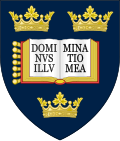Overview
The Department's research spans levels from molecules to ecosystems in order to address fundamental questions relating to food security, plant molecular biology, disease biology, evolutionary mechanisms, conservation biology, biodiversity, evolutionary developmental biology, climate change and animal behaviour. This department also delivers the teaching of an undergraduate MBiol degree in biology. [6] [7] Within its research portfolio, the department incorporates several research institutes such as the Edward Grey Institute of Field Ornithology (EGI), the Wildlife Conservation Research Unit (WildCRU); as well as housing the Oxford University Herbaria. Several members of academic staff work within the Peter Medawar Building for Pathogen Research [8] and were involved in addressing the COVID-19 pandemic. [9] [10]
Additional partnerships and resources of the Department include the Oxford University Museum of Natural History, the Oxford Botanic Garden and Arboretum, the John Krebs Field Station and Wytham Woods.
History
The Department of Biology was formed from the merging of the former Departments of Plant Sciences and Zoology on the 1 August 2022. [3]
The former Department of Zoology, founded in 1860, was housed in the Tinbergen Building until it was demolished in Spring 2022. [12] Designed in 1965 by Sir Leslie Martin (who also designed the Royal Festival Hall) and opened in 1971, the Tinbergen Building was a large Modernist building housing over 1,600 staff and students. [13] It was Oxford University's largest building at the time. In February 2017, university officials announced that the Tinbergen Building would be closed for two years and all research and teaching activities of the Department would be moved elsewhere. This was due to the discovery of more asbestos than had been previously known; too much than could be removed during necessary maintenance with the building remaining occupied. [14] [12]
The former Department of Plant Sciences was formed from the Imperial Forestry Institute. The 'Imperial Forestry Institute' was formed from in 1924,; [15] [16] later it became the Commonwealth Forestry Institute from 1939. [17] [18] The Oxford Forestry Institute was incorporated and became the Department of Plant Sciences in 2002. [19]
In January 2021, the Oxford City Council approved the £200m construction of the Life and Mind Building, which will be the university's largest building project and house the Departments of Experimental Psychology and Biology. [20] [21] It will replace the Tinbergen Building on South Parks Road. The building will feature multiple laboratories, teaching and testing spaces providing research facilities for 800 students and 1200 researchers. Work started in 2021, with the building expected to open in 2025. [22] [23]
This page is based on this
Wikipedia article Text is available under the
CC BY-SA 4.0 license; additional terms may apply.
Images, videos and audio are available under their respective licenses.

